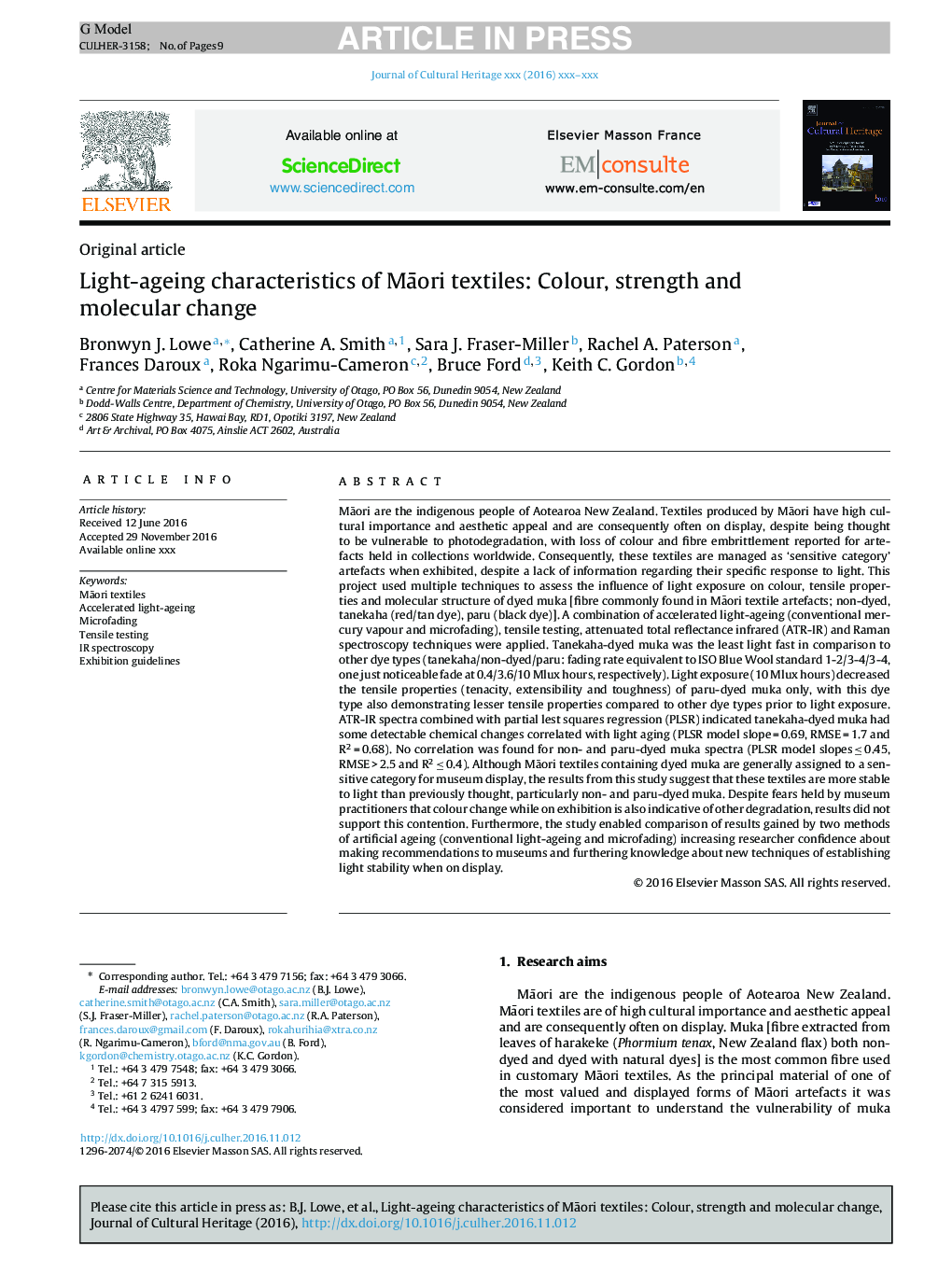| کد مقاله | کد نشریه | سال انتشار | مقاله انگلیسی | نسخه تمام متن |
|---|---|---|---|---|
| 5112670 | 1483952 | 2017 | 9 صفحه PDF | دانلود رایگان |
عنوان انگلیسی مقاله ISI
Light-ageing characteristics of MÄori textiles: Colour, strength and molecular change
دانلود مقاله + سفارش ترجمه
دانلود مقاله ISI انگلیسی
رایگان برای ایرانیان
موضوعات مرتبط
مهندسی و علوم پایه
شیمی
شیمی تئوریک و عملی
پیش نمایش صفحه اول مقاله

چکیده انگلیسی
MÄori are the indigenous people of Aotearoa New Zealand. Textiles produced by MÄori have high cultural importance and aesthetic appeal and are consequently often on display, despite being thought to be vulnerable to photodegradation, with loss of colour and fibre embrittlement reported for artefacts held in collections worldwide. Consequently, these textiles are managed as 'sensitive category' artefacts when exhibited, despite a lack of information regarding their specific response to light. This project used multiple techniques to assess the influence of light exposure on colour, tensile properties and molecular structure of dyed muka [fibre commonly found in MÄori textile artefacts; non-dyed, tanekaha (red/tan dye), paru (black dye)]. A combination of accelerated light-ageing (conventional mercury vapour and microfading), tensile testing, attenuated total reflectance infrared (ATR-IR) and Raman spectroscopy techniques were applied. Tanekaha-dyed muka was the least light fast in comparison to other dye types (tanekaha/non-dyed/paru: fading rate equivalent to ISO Blue Wool standard 1-2/3-4/3-4, one just noticeable fade at 0.4/3.6/10 Mlux hours, respectively). Light exposure (10 Mlux hours) decreased the tensile properties (tenacity, extensibility and toughness) of paru-dyed muka only, with this dye type also demonstrating lesser tensile properties compared to other dye types prior to light exposure. ATR-IR spectra combined with partial lest squares regression (PLSR) indicated tanekaha-dyed muka had some detectable chemical changes correlated with light aging (PLSR model slope = 0.69, RMSE = 1.7 and R2 = 0.68). No correlation was found for non- and paru-dyed muka spectra (PLSR model slopes â¤Â 0.45, RMSE > 2.5 and R2 â¤Â 0.4). Although MÄori textiles containing dyed muka are generally assigned to a sensitive category for museum display, the results from this study suggest that these textiles are more stable to light than previously thought, particularly non- and paru-dyed muka. Despite fears held by museum practitioners that colour change while on exhibition is also indicative of other degradation, results did not support this contention. Furthermore, the study enabled comparison of results gained by two methods of artificial ageing (conventional light-ageing and microfading) increasing researcher confidence about making recommendations to museums and furthering knowledge about new techniques of establishing light stability when on display.
ناشر
Database: Elsevier - ScienceDirect (ساینس دایرکت)
Journal: Journal of Cultural Heritage - Volume 24, MarchâApril 2017, Pages 60-68
Journal: Journal of Cultural Heritage - Volume 24, MarchâApril 2017, Pages 60-68
نویسندگان
Bronwyn J. Lowe, Catherine A. Smith, Sara J. Fraser-Miller, Rachel A. Paterson, Frances Daroux, Roka Ngarimu-Cameron, Bruce Ford, Keith C. Gordon,